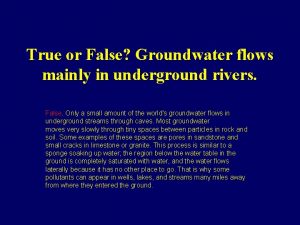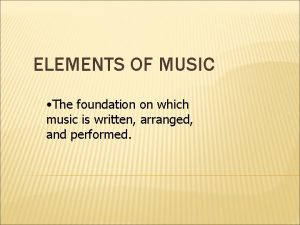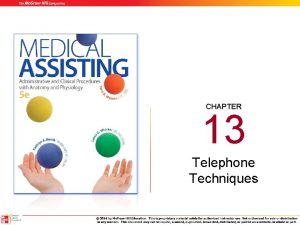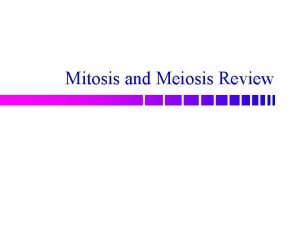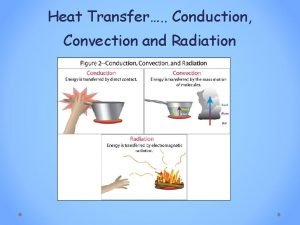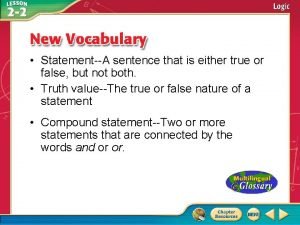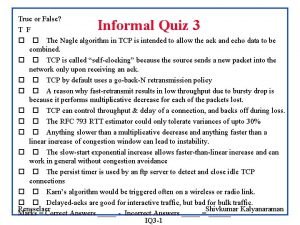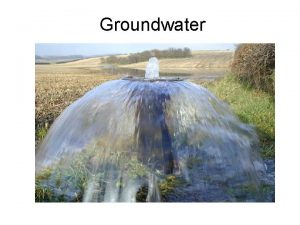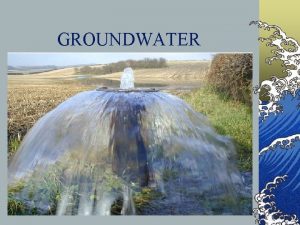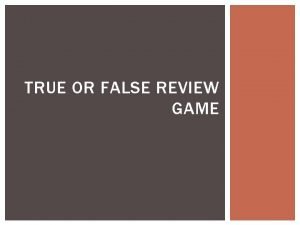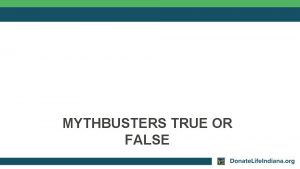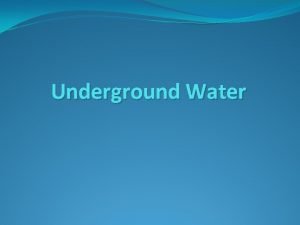True or False Groundwater flows mainly in underground












- Slides: 12

True or False? Groundwater flows mainly in underground rivers. False. Only a small amount of the world's groundwater flows in underground streams through caves. Most groundwater moves very slowly through tiny spaces between particles in rock and soil. Some examples of these spaces are pores in sandstone and small cracks in limestone or granite. This process is similar to a sponge soaking up water; the region below the water table in the ground is completely saturated with water, and the water flows laterally because it has no other place to go. That is why some pollutants can appear in wells, lakes, and streams many miles away from where they entered the ground.

True or False? Groundwater is not connected to rivers and lakes. False. Groundwater is connected to rivers and lakes, and vice versa! This connection is usually through wetlands and springs. (A good way to think of this is the cold water that you may suddenly feel when you swim in a lake. That's groundwater entering the lake as a spring!) Groundwater and surface water are connected, so pollution can pass from one to the other very easily.

True or False? Contaminants from oil that is poured on the ground will be filtered by soil and gravel before reaching groundwater. False. Most people have heard that soil acts as a filter. Some soil types can filter some chemicals. That is how septic systems filter bacteria and nitrogen compounds from waste water. Some chemicals, such as benzene, toluene, ethyl benzene, and xylene (BTEX), which are added to gasoline to increase octane, are not filtered by soils and often reach groundwater.

True or False? Most Montana residents rely on groundwater for drinking and household needs. True. More than 70% of all residents rely on groundwater for their drinking water and household needs. Nationwide, groundwater supplies half of the water for households and agricultural irrigation, and about one-third of industrial water needs.

True or False? Contaminated groundwater can eventually enter surface water and contaminate it. True. Groundwater and surface water are connected; therefore, if one is contaminated, it is possible that the other is contaminated nearby as well. Specifically, contaminants can spread from groundwater to surface water when the water level of a stream, lake, or wetland is at or below the water table of the aquifer next to it, so that it "gains" water from the ground

True or False? Most groundwater in the northern U. S. comes from Canada. False. Some people believe this myth to be true because they may equate water "flowing down" with flowing south. Actually, water flows downhill, whatever direction that happens to be. For example, groundwater may flow into Lake Helena from any direction that is upslope. Generally, groundwater in the Helena Valley is recharged locally or regionally by rain or snowmelt.

True or False? Groundwater and surface water may be connected through wetlands. True. Groundwater can flow into--or out of--wetlands (springs or flowthrough wetlands; Fig. 2), which may in turn flow into lakes and streams.

True or False? The surface of a lake is at the same level as the groundwater surface (water table) next to it. True. One way to remember this is to think of a beach next to a lake or ocean; if you dig a hole into the sand that goes deeper than the lake's level, it will begin to fill with water (groundwater).

True or False? If a well reaches groundwater, an unlimited amount of water can be pumped. False. The amount of water that a well can pump depends on the soil or rock formations of the aquifer. For example, fractured granite can hold huge amounts of water, but the water is not easily extracted if the fractures aren't well connected to one another. Clay also holds a lot of water, but the tiny pore spaces do not allow the water to flow readily.

True or False? Contaminated surface water can eventually enter groundwater and contaminate it. True. Groundwater and surface water are connected. This type of contamination can occur if a stream, lake, or wetland is higher than an adjacent aquifer to which it "loses" water (Fig. 3). Rainfall or snowmelt can also seep through contaminated soil, carrying pollutants to aquifers below.

True or False? Depending on the type of soil or rock, groundwater will flow at different rates. True. Each type of soil or rock has a level of permeability, which is a measure of the speed at which water moves through porous material. For example, gravel and sand have higher permeability than clay. Some flow paths are also longer than others

True or False? Rain and snowmelt infiltrate (seep) into the ground to become groundwater. True. The ground is like a sponge and soaks up water until it is saturated. However, if rain is falling or snow is melting faster than it can seep into the ground, it will flow downhill and enter lakes and rivers as runoff.
 True or false true or false
True or false true or false Groundwater true/false quiz answers
Groundwater true/false quiz answers Slidetodoc
Slidetodoc Steroid hormones are water soluble. true false
Steroid hormones are water soluble. true false Identify each statement as either true or false.
Identify each statement as either true or false. True or false
True or false Tempo
Tempo Chapter 14 telephone techniques
Chapter 14 telephone techniques Meiosis has 8 main phases true or false
Meiosis has 8 main phases true or false Method of heat transfer
Method of heat transfer Which sentence diagram shows a compound sentence?
Which sentence diagram shows a compound sentence? True false
True false True false algorithm
True false algorithm

